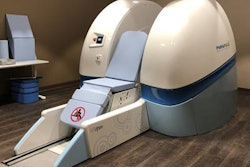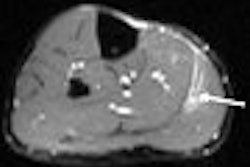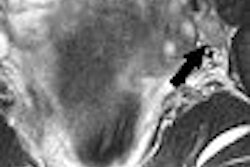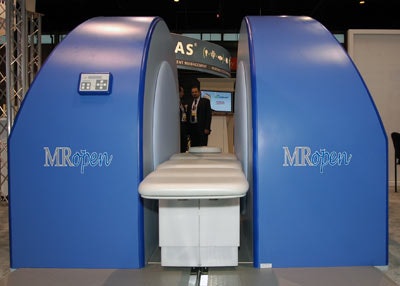
An Italian company called Paramed Medical Systems has developed a novel new magnet design that turns traditional MRI instrumentation on its head. In addition to introducing an intriguing new open-magnet configuration, the company's design also incorporates a new type of superconducting material that could lead to more compact, economical scanner designs.
In the decades since its invention, MRI magnet instrumentation has been dominated by a small number of design architectures, from the classic "doughnut-hole" cylindrical magnet used on high-field superconducting systems to the C-shaped configuration commonly found on permanent-magnet units. Other designs have employed dual slabs above and below the patient, supported by pillars.
At the 2006 RSNA conference in Chicago, Paramed of Genoa demonstrated as a work-in-progress its MR-Open system, which employs a cryogen-free 0.5-tesla superconducting magnet in a U-shaped configuration that's designed to reduce claustrophobia by creating open space above the patient's head and body.
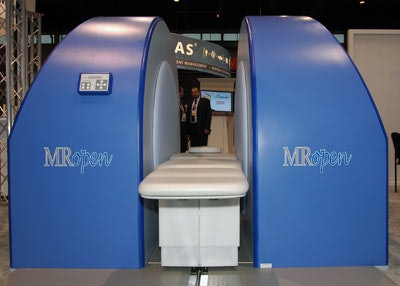 |
| Paramed's MR-Open scanner is based on MgB2 superconducting material and a novel open architecture. |
Paramed believes MR-Open is even more patient-friendly than C-shaped open magnet designs, which despite their open sides still leave patients staring at a slab of magnet during procedures. MR-Open's 60-cm patient gap is also wider than those found on C-shaped units.
The novel design of MR-Open is possible due to its use of a new type of wire material called magnesium diboride, which replaces the niobium titanium wire used in traditional superconducting systems. magnesium diboride's superconducting properties were discovered just over five years ago, and it is considered to be a simple and relatively inexpensive superconducting material with a higher superconducting temperature than niobium titanium.
To develop MR-Open, Paramed worked with Italian firm ASG Superconductors of Genoa, which developed the magnesium diboride technology and was looking for a partner in the medical field, according to Marino Palazzolo, marketing director of Paramed.
"The magnet is a high-temperature superconductor," Palazzolo said. "That means it's cryogen-free, no helium, no refrigeration gas or fluids. That makes the installation much easier, more similar to the installation of a permanent magnet, but with the advantages of a superconducting one."
Paramed plans to position MR-Open as a whole-body general-purpose magnet. The system's versatility is enhanced by the fact that its transverse field means that users can employ both flat coils for spine imaging and solenoidal coils for brain studies, Palazzolo said. The system's gradients are rated at 20 milliTesla per meter (mTm) with a 500-msec rise time.
Paramed hopes to have MR-Open on the European market in mid-2007, with the company handling sales of the system directly in Europe. In the U.S., the company still needs to clear the system through the U.S. Food and Drug Administration. Once 510(k) clearance is received, Paramed will probably rely on U.S. distributors, such as its relationship with Extremity Imaging Partners, a Pittsburgh-based firm that already handles Paramed's MrJ dedicated extremity scanner.
How much will MR-Open cost once it hits the market? C-shaped permanent magnet MRI systems typically have list prices from $1.1 million to $1.3 million, and Paramed believes MR-Open will be at the low end of that range, the company said.
In Europe, Paramed acts as both a manufacturer and distributor, with the firm selling the dedicated breast MRI scanner developed by Aurora Imaging Technology of Andover, MA, as well as PACS software from Mercury Computer Systems of Chelmsford, MA. Paramed is also developing a digital radiography system, according to Palazzolo.
Ultimately, the magnesium diboride technology used in MR-Open could also find a home in more conventional MRI designs, such as 1.5- and 3-tesla superconducting magnets, which would have shorter magnet bores and be more compact than current systems, according to David Weissburg, vice president of Americas for Paramed.
"ASG provides magnets to many manufacturers, and this breakthrough magnet technology is being considered by several other very large MRI manufacturers," he said. "This establishes a new performance level for MRI."
By Brian Casey
AuntMinnie.com staff writer
January 15, 2007
Related Reading
Paramed introduces MR-Open, November 6, 2006
Copyright © 2007 AuntMinnie.com




